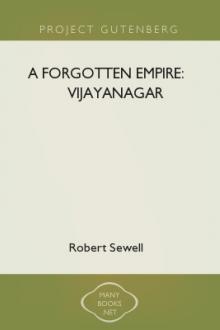A Forgotten Empire: Vijayanagar by Robert Sewell (short story to read TXT) 📕

- Author: Robert Sewell
- Performer: -
Book online «A Forgotten Empire: Vijayanagar by Robert Sewell (short story to read TXT) 📕». Author Robert Sewell
[142] — About two hundred yards by fifteen.
[143] — All this seems to have disappeared, but the buildings may have stood on each side of what is now the main road from Kamalapura to Hampi — “behind the Mint,” as the author stood.
[144] — The India Office copy adds here: “He was exceedingly young.” If so, the personage whom the ambassador interviewed could hardly have been Deva Raya II., who at this period (1443) had been on the throne for twenty-four years.
[145] — MAHANADI (Hakluyt), MAHANAWI (Elliot). There can be little doubt as to the meaning.
[146] — The actual moment of the new moon corresponding to the beginning of the month of Karttika in Hindu reckoning was 7.40 A.M. on the morning of October 23, and the first Hindu day (TITHI) of Karttika began at 5 A.M. on October 24. The Muhammadan month begins with the heliacal rising of the moon, and this may have taken place on the 24th or 25th evening. At any rate, Razzak could hardly have called a festival that took place a whole month earlier a festival which took place “during three days in the month Rajab.” Hence I think that he must have been present at the New Year festivities in Karttika, not at the Mahanavami in Asvina, a month previous. Note Paes’ description of the festivals at which he was present. He states that the nine days’ MAHANAVAMI took place on September 12, when he was at Vijayanagar, and the details correspond to the year A.D. 1520. September 12, 1520, was the first day of the month Asvina. The New Year’s festival that year took place on October 12, which corresponded to the first day of Karttika, each of these being the day following the NEW moon, not the full moon.
[147] — About seven yards or twenty-one feet.
[148] — Genealogical table in EPIGRAPHIA INDICA, iii. 36.
[149] — Dr. Hultzsch (EPIG. IND., iii. 36, and note; IND. ANT., xxi. 321). The last is on a temple at Little Conjeeveram and is dated in Saka 1387 expired, year Parthiva.
[150] — Saka 1392 expired, year Vikriti, on the same temple (IND. ANT., xxi. 321 — 322).
[151] — Firishtah says that he reigned twenty-three years nine months and twenty days, which gives this date. The BURHAN-I MAASIR fixes his decease at the end of Junmada’l Awwal A.H. 862, which answers to April A.D. 1458. Major King states that another authority gives the date as four years later (IND. ANT., Sept. 1899, p. 242, note).
[152] — 28th Zil-kada A.H. 865.
[153] — 13th Zil-kada A.H. 867.
[154] — Dec. I. viii. c. 10.
[155] — Below, p. 305.
[156] — IND. ANT., November 1899, p. 286, note.
[157] — Vijayanagar.
[158] — Masulipatam.
[159] — Scott’s translation has “Ghondpore” (i. 166); Briggs (ii. 500) says “Condapilly.”
[160] — This evidently means Kanchi or Conjeeveram; but the story is exceedingly improbable. The distance was 250 miles, and the way lay through the heart of a hostile country.
[161] — Ramazan A.H. 885.
[162] — 11th Muharram, A.H. 886.
[163] — Scott’s translation, i. 167.
[164] — It is possible that one of these towns was Goa, which was taken in 1469.
[165] — Meaning evidently palanquins.
[166] — “Chenudar” and “Binedar” appear to be variations of the name Vijayanagar, called “Bichenegher” farther on.
[167] — This may, perhaps, refer to Belgaum (A.D. 1471).
[168] — Mahamandalesvara Medinisvara Gandan Kattari Saluva Dharanivaraha Narasimha Raya Udaiyar. These are not the titles of a sovereign. (Hultzsch, “South Indian Inscriptions,” i. 131, No. 116).
[169] — OP. CIT., p. 132, No. 119.
[170] — OP. CIT., p. 131.
[171] — Scott’s “Firishtah,” i. pp. 190, 210; Briggs, ii. 537, iii. 10.
[172] — Briggs calls him “Timraj” (ii. 538) in all cases whence I conclude that in this passage Scott’s “Ramraaje” is a slip of the pen. It does not occur again. The former translator in the second of the two passages calls “Timraj” the general of the Roy of Beejanuggur.
[173] — Scott, i. p 228.
[174] — Scott, i. p. 262.
[175] — This is very similar to the story told by Nuniz of the two sons of Virupaksha.
[176] — This again is similar to the tale Nuniz gives us of the minister Narasa and the two young princes.
[177] — Scott, i. p. 252; Briggs, iii. 66.
[178] — Firishtah has told us in a previous paragraph that “dissensions prevailed in Beejanuggur.”
[179] — April A.D. 1493.
[180] — Scott’s note to this is “about one million eight hundred thousand pounds sterling.” Briggs (iii. p. 13) says two millions.
[181] — April 1509 to April 1510.
[182] — Da Orta was at Vijayanagar in 1534, at the same time as our chronicler Nuniz.
[183] — Colloq., x.
[184] — May 20th, according to Barros.
[185] — Published by the Hakluyt Society in English.
[186] — The origin of the name “Sabayo” has often been discussed, and never, I think, quite satisfactorily explained. Several of the old writers have exercised their ingenuity on the question. Barros (Dec. II. l. v. cap. 1) writes: “AO TEMPO CUE NOS ENTRAMOS NA INDIA, ERA SENHOR DESTA CIDADE GOA HUM MOURO PER NOME SOAI, CAPITAO D’EL REY DO DECAN, A QUE COMMUNAMENTE CHAMAMOS SABAYO” — “When we arrived in India, the lord of this city of Goa was a Moor, by name Soai, captain of the king of the Dakhan, whom we commonly call Sabayo.” But Barros must not always be depended upon for Indian names. He explains “Sabayo” as derived from SABA or SAVA — “Persian,” and says that the Sabayo’s son was Adil Shah. Garcia da Orta derives it from SAHIB, Burton (LUSIADS, iii. p. 290) thinks it was a corruption of SIPANDAR or “military governor.”
[187] — I have not seen the original, and suspect an error of translation here.
[188] — Compare the account given by Paes as to his horse, which he saw at the Mahanavami festival, and at the review which followed (pp. 272, 278 below).
[189] — EPIG. IND., i. 366; IND. ANT., xxiv. 205.
[190] — Henry VIII. of England succeeded to the throne on April 22nd of the same year. It is interesting, when reading the description of the splendours of Krishna Raya’s court in the narrative of Nuniz, to remember that in Western Europe magnificence of display and personal adornment seems to have reached its highest pitch at the same period.
[191] — The chief of Bankapur seems to have been a Mahratta. Nuniz calls him the “Guym de Bengapor.” Albuquerque styles him “King Vengapor” about A.D. 1512 (Hakluyt edit., iii. 187).
Osorio writes: — “EST AUTEM VENGAPOR REGIO MEDITERRANEA, CUM ZABAIMI REGIONE CONTINENS” (p. 263).
Castanheda states that Albuquerque, then Governor-General of Goa, sent two embassies, one to Vijayanagar and one to “Vengapor,” as if the latter were independent; and adds of the chief of Vengapor, “His kingdom is a veritable and safe road to Narsinga, and well supplied with provisions.”
Barros speaks of the same event, calling the place “Bengapor” and stating explicitly that its king was “vassal of Narsinga” (or Vijayanagar) (Dec. II. l. v. cap. 3). Subsequently, writing of the chiefs in the same neighbourhood, Barros speaks of two brothers, “Comogij” and “Appagij” (Dec. III. l. iv. cap. 5), and describing Krishna Deva Raya’s march towards Raichur — recapitulating the story and details given by Nuniz — he speaks of “the Gim of the city of Bengapor.” In l. v. cap. 3 of the same Decade Barros says that “Bengapor” was “on the road” to Vijayanagar. “Gim,” “Guym” and other names appear to be renderings of the Mahratta honorific “Ji.”
Bankapur was one of the most important fortresses in the Karnataka country, situated forty miles south of Dharwar on the direct road from Honawar to Vijayanagar. The road from Bhatkal, a favourite landing-place, first went northwards to Honawar, then inland to Bankapur, and thence to Banavasi, Ranibennur, and over the plains to Hospett and Vijayanagar. It was known as early as A.D. 848, and remained in possession of Hindu rulers down to 1573, when it was captured by Ali Adil Shah and its beautiful temple destroyed. Firishtah calls the place “Beekapore” and “Binkapor” (Scott’s edit., i. 47, 69, 85, 86, 119, 301, &c).
[192] — “Commentaries of Afonso Dalboquerque” (Hakluyt edit., ii. p. 73). Fr. Luis left Cochin, travelled to Bhatkal, and thence to Vijayanagar.
[193] — Dec II. l. v. cap. 3.
[194] — See also Castanheda, who was in India in 1529 (Lib. iii. cap. 12).
[195] — As before stated, Firishtah mentions this event (Scott, i. 225).
[196] — Purchas’s summary of the Portuguese conquest of Goa runs as follows: “SABAIUS (I.E. the “Sabayo”) when he died, left his sonne IDALCAN (Adil Khan) very young; whereupon his Subjects rebelled, and the King of Narsinga warred upon him, to dispossesse him of his Dominion. Albuquerque, taking his opportunitie, besieged and … took Goa with the Iland. Which was soon after recovered by Idalcan, comming with a strong Armie thither, the Portugal flying away by night. But when the King of Narsinga again invaded Idalcan, He was forced to resist the more dangerous Enemy, leaving a strong Garrison at Goa, which yet ALBUQUERK overcame, and sacked the Citie.” Purchas’s work was published (folio) in 1626. He merely follows Barros (Dec. I. l. viii cap. 10).
[197] — “Commentaries of Afonso Dalboquerque” (Hakluyt edit, iii. 35).
[198] — The name may represent “Timma Raja.”
[199] — “Commentaries of Dalboquerque,” iii. pp. 246 — 247.
[200] — Firishtah (Scott), i. p. 236.
[201] — “Commentaries of Dalboquerque,” iv. 121.
[202] — “East Africa and Malabar” (Hakluyt edit., pp. 73, &c.). Barbosa was son of Diego Barbosa, who sailed in the first fleet sent out under Joao de Nova in 1501. He gives no dates in his own writings except that he finished his work in 1516 (Preface), after “having navigated for a great part of his youth in the East Indies.” It was probably begun about 1514. He was certainly in the Indian Ocean in 1508 — 9. The heading of the work is “Description of the East Indies and Countries on the sea-board of the Indian Ocean in 1514.” It was published in Spanish (translated from the Portuguese) in 1524. The copy in the Library at Barcelona is said to be the oldest extant.
[203] — This name awaits explanation.
[204] — This probably refers to the highly decorated building in the interior of what I believe to have been the Government offices, surrounded by a lofty wall with watch-towers, and often called “The Zenana” The elephant stables lie to the east of it. The building in question is “No. 29 Council Room” on the Government plan.
[205] — Barbosa in A.D. 1514 mentions this expedition.
[206] — An inscription at Kondavid glorifying Saluva Timma states that he took the fortress on Saturday, June 23, A.D. 1515 (Ashadha Sukla Harivasara Saurau, Saka 1437). This information was kindly supplied to me by Dr. Luders.
[207] — There is a long inscription in the temple of Varadarajasvami at Conjeeveram exactly confirming this whole story, It relates that the king first captured Udayagiri, Bellamkonda, Vinukonda, Kondavid, and other places; then Bezvada and Kondapalle, and finally Rajahmundry.
[208] — Pp 354 to 371.
[209] — Krishna Raya in 1515 was only about twenty-nine years old; but we must not forget the Hindu custom of the marriages of girls while infants.
[210] — If this refers to Krishna Raya’s capture of that place in 1515, it is to be noted here that Nuniz asserts that it was taken,





Comments (0)